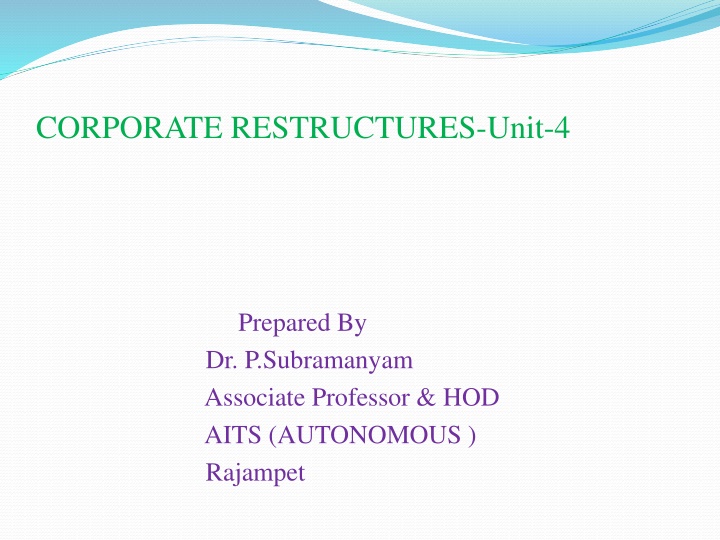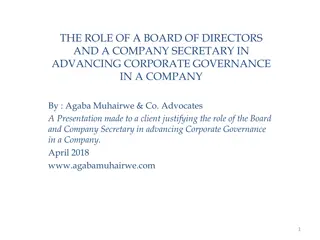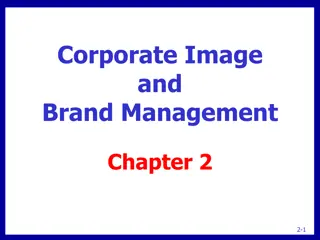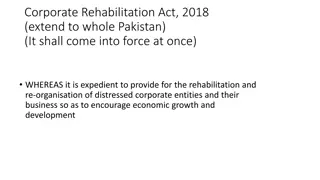CORPORATE RESTRUCTURES-Unit-4
Corporate restructuring involves significant changes in a company's model, management, and structure to address challenges, increase shareholder value, and achieve predetermined objectives. It aims at enhancing economy, improving efficiency, and leveraging resources to stay competitive in the market.
Download Presentation

Please find below an Image/Link to download the presentation.
The content on the website is provided AS IS for your information and personal use only. It may not be sold, licensed, or shared on other websites without obtaining consent from the author.If you encounter any issues during the download, it is possible that the publisher has removed the file from their server.
You are allowed to download the files provided on this website for personal or commercial use, subject to the condition that they are used lawfully. All files are the property of their respective owners.
The content on the website is provided AS IS for your information and personal use only. It may not be sold, licensed, or shared on other websites without obtaining consent from the author.
E N D
Presentation Transcript
CORPORATE RESTRUCTURES-Unit-4 Prepared By Dr. P.Subramanyam Associate Professor & HOD AITS (AUTONOMOUS ) Rajampet
CORPORATE RESTRUCTURES-Unit-4 Meaning of corporate restructures- Restructuring as per Oxford dictionary means to give a new structure to, rebuild or rearrange". As per Collins English dictionary, meaning of corporate restructuring is a change in the business strategy of an organization resulting in diversification, closing parts of the business, etc, to increase its long- term profitability. Corporate restructuring is defined as the process involved in changing the organization of a business. Corporate restructuring can involve making dramatic changes to a business by cutting out or merging departments. It implies rearranging the business for increased efficiency and profitability. In other words, it is a comprehensive process, by which a company can consolidate its business operations and strengthen its position for achieving corporate objectives-synergies and continuing as competitive and successful entity.
Scope of Corporate Corporate restructuring is the process of significantly changing a company's business model, management team or financial structure to address challenges and increase shareholder value. Corporate restructuring is an inorganic growth strategy. Corporate Restructuring is concerned with arranging the business activities of the corporate as a whole so as to achieve certain predetermined objectives at corporate level. Such objectives include the following: orderly redirection of the firm's activities; Deploying surplus cash from one business to finance profitable growth in another; exploiting inter-dependence among present or prospective businesses within the corporate portfolio; risk reduction; and development of core competencies.
Scope The scope of Corporate Restructuring encompasses enhancing economy (cost reduction) and improving efficiency (profitability). When a company wants to grow or survive in a competitive environment, it needs to restructure itself and focus on its competitive advantage. The survival and growth of companies in this environment depends on their ability to pool all their resources and put them to optimum use. A larger company, resulting from merger of smaller ones, can achieve economies of scale. If the size is bigger, it enjoys a higher corporate status. The status allows it to leverage the same to its own advantage by being able to raise larger funds at lower costs. Reducing the cost of capital translates into profits. Availability of funds allows the enterprise to grow in all levels and thereby become more and more competitive.
Types of Corporate Restructuring Financial Restructuring: This type of restructuring may take place due to a severe fall in the overall sales because of adverse economic conditions. Here, the corporate entity may alter its equity pattern, debt-servicing schedule, equity holdings, and cross-holding pattern. All this is done to sustain the market and the profitability of the company. Organizational Restructuring: Organizational Restructuring implies a change in the organizational structure of a company, such as reducing its level of the hierarchy, redesigning the job positions, downsizing the employees, and changing the reporting relationships. This type of restructuring is done to cut down the cost and to pay off the outstanding debt to continue with the business operations in some manner.
Reasons for Corporate Restructuring 1. Change in the Strategy- The management of the distressed entity attempts to improve its performance by eliminating certain divisions and subsidiaries which do not align with the core strategy of the company. 2. Lack of Profits or Absence of Profits- The undertaking may not be enough profit-making to cover the cost of capital of the company and may cause economic losses 3. Reverse Synergy: According to reverse synergy, the value of an individual unit may be more than the merged unit 4. Cash Flow Requirement: Disposing of an unproductive undertaking can provide a considerable cash inflow to the company.
Characteristics of Corporate Restructuring 1. To improve the Balance Sheet of the company (by disposing of the unprofitable division from its core business) 2. Staff reduction (by closing down or selling off the unprofitable portion) Changes in corporate management 3. Disposing of the underutilized assets, such as brands/patent rights. 4. Outsourcing its operations such as technical support and payroll management to a more efficient 3rd party. 5. Shifting of operations such as moving of manufacturing operations to lower- cost locations. 6. Reorganizing functions such as marketing, sales, and distribution. Renegotiating labor contracts to reduce overhead. 7. .Rescheduling or refinancing of debt to minimize the interest payments. Conducting a public relations campaign at large to reposition the company with its consumers.
Types of Corporate Restructuring Strategies Merger: This is the concept where two or more business entities are merged together either by way of absorption or amalgamation or by forming a new company. The merger of two or more business entities is generally done by the exchange of securities between the acquiring and the target company. Eaxmples for merger A. Vodafone India and Idea Cellular (2018): Kotak Mahindra Bank and ING Vysya Bank (2015): HDFC Bank and Centurion Bank of Punjab (2008): Disney and Pixar (2006): Demerger: Under this corporate restructuring strategy, two or more companies are combined into a single company to get the benefit of synergy arising out of such a merger. Example Vedanta Limited and Cairn India Limited (2016) Reverse Merger: In this strategy, the unlisted public companies have the opportunity to convert into a listed public company, without opting for IPO (Initial Public offer). In this strategy, the private company acquires a majority shareholding in the public company with its own name. Disinvestment: When a corporate entity sells out or liquidates an asset or subsidiary, it is known as divestiture . Takeover/Acquisition: Under this strategy, the acquiring company takes overall control of the target company. It is also known as the Acquisition.
Joint Venture (JV): Under this strategy, an entity is formed by two or more companies to undertake financial act together. The entity created is called the Joint Venture. Both the parties agree to contribute in proportion as agreed to form a new entity and also share the expenses, revenues and control of the company. Strategic Alliance: Under this strategy, two or more entities enter into an agreement to collaborate with each other, in order to achieve certain objectives while still acting as independent organisations. Slump Sale: Under this strategy, an entity transfers one or more undertakings for lump sum consideration. Under Slump Sale, an undertaking is sold for consideration irrespective of the individual values of the assets or liabilities of the undertaking.
Types of Mergers Merger is the combination of two or more companies which can be merged together either by way of amalgamation or absorption. The combining of two or more companies, is generally by offering the stockholders of one company securities in the acquiring company in exchange for the surrender of their stock. 1. Horizontal Merger: It is a merger of two or more companies that compete in the same industry. It is a merger with a direct competitor and hence expands as the firm's operations in the same industry. Horizontal mergers are designed to achieve economies of scale and result in reduce the number of competitors in the industry Example- Hindustan Unilever Limited (HUL) and GlaxoSmithKline Consumer Healthcare (2018): 2. Vertical Merger: It is a merger which takes place upon the combination of two companies which are operating in the same industry but at different stages of production or distribution system. If a company takes over its supplier/producers of raw material, then it may result in backward integration of its activities. On the other hand, Forward integration may result if a company decides to take over the retailer or Customer Company. Vertical merger provides a way for total integration to those firms which are striving for owning of all phases of the production schedule together with the marketing network
3. Co generic Merger: It is the type of merger, where two companies are in the same or related industries but do not offer the same products, but related products and may share similar distribution channels, providing synergies for the merger. The potential benefit from these mergers is high because these transactions offer opportunities to diversify around a common case of strategic resources. 4. Conglomerate Merger: These mergers involve firms engaged in unrelated type of activities i.e. the business of two companies are not related to each other horizontally nor vertically. In a pure conglomerate, there are no important common factors between the companies in production, marketing, research and development and technology. Conglomerate mergers are merger of different kinds of businesses under one flagship company. The purpose of merger remains utilization of financial resources enlarged debt capacity and also synergy of managerial functions
Reasons for Merger Reasons for Mergers and Acquisitions 1.To grow the business 2.To achieve revenue synergies 3.To achieve economies of scale 4.To diversify 5..To vertically integrate the business 6.To avail of tax benefits 7.For knowledge transfer 8. Access to Talent
What is Acquisition Different Types of acquisitions Acquisition essentially means to acquire or to takeover . Here a bigger company will take over the shares and assets of the smaller company. A. Friendly acquisition - Both the companies approve of the acquisition under friendly terms. B. Reverse acquisition -A private company takes over a public company. C. Back flip acquisition-A very rare case of acquisition in which, the purchasing company becomes a subsidiary of the purchased company. D. Hostile acquisition - Here, as the name suggests, the entire process is done by force Different Types of acquisitions
Reasons for Acquisition 1. Industry Consolidation - Tactical move that enables a company to reposition itself (with a merger partner) into a stronger operational and competitive industry position. 2. Improve Competitive Position -Reduces competition, and allows the combined firm to use its resources more effectively. 3. Defensive Move -Attractive tactical move in any economic environment - particularly in a cyclical down-turn where a merger can be a strong defensive move. 4. Synergies- Allowing two companies to work more efficiently together than either would separately. 5. Market / Business / Product Line Issues -Whether the market is a new product, a business line, or a geographical region, market entry or expansion is a powerful reason for a merger. 6. Acquire Resources and Skills- To obtain access to the resources of another company or to combine the resources of the two companies
Take over A "takeover" refers to the acquisition or assumption of control over one company by another. It is a corporate action where a company, often referred to as the acquiring or parent company, purchases a significant portion of the ownership (shares) or assets of another company, known as the target or acquired company. The acquiring company gains control over the operations, assets, and management of the target company. Takeovers can occur through various means, including the purchase of shares, assets, or a combination of both. The level of control acquired can vary, ranging from a partial ownership stake to complete control over the target company. Takeovers can be classified into various types based on the nature of the transaction, the relationship between the acquiring and target companies, and the level of approval and cooperation involved.
Definitions of Takeover Assumption of control of another (usually smaller) firm through purchase of 51 percent or more of its voting shares or stock. General term referring to transfer of control of a firm from one group of shareholders to another group of shareholders. MEANING OF TAKEOVER:- Takeover is a transaction whereby a person acquires control overthe company either :directly by becoming the owner of the Company; or in directly by obtaining control of the management of the company. Take Over taking over the control of management Substantial acquisition of shares or voting Rights - acquiring Substantial quantity of shares or voting rights
Types of Takeover Friendly takeover- It occurs when both the acquiring and the acquired companies mutually agree to the terms of the acquisition. In such a situation, the acquiree company openly declares its intention to sell, and after discussions and negotiations, the takeover process is completed without any disputes. Hostile takeover- This type of takeover occurs when the acquiree company does not consent to be acquired, and the company taking over purchases a majority of shares from the open market without the consent of the acquiree company. This may lead to disagreements between the board of directors of both companies. The board of directors of the acquired company may leave the new entity to show their disapproval of the hostile takeover. Reverse takeover- It occurs when a private company that wants to go public buys a controlling interest in a publicly listed company. This allows the private company to save expenses related to raising capital through an IPO. In summary, takeovers can be either friendly or hostile, and a reverse takeover is another form that occurs when a privately held company wants to go public.
Backflip take over- A backflip takeover is any sort of takeover in which the acquiring companyturns itself into a subsidiary of thepurchased company. This type of takeover rarely occur Bailout Takeover: Struggling businesses get rescued under the rehabilitation schemes set forth by the financial institutions. The acquirer has to put forward a proposal to the financial institution for acquiring the target company























